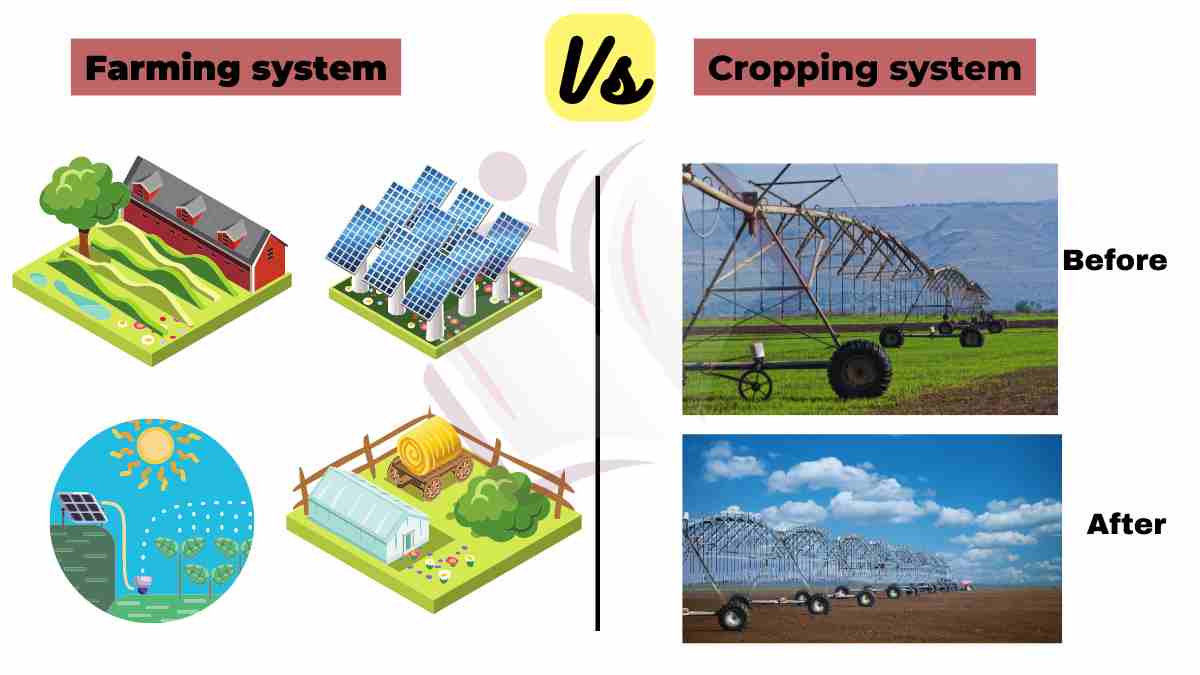The major difference between farming and cropping system is that Farming encompasses a broader spectrum of agricultural activities while the cropping system specifically refers to the cultivation and management of crops within a farm.

What is Farming System?
A farming system refers to the combination of practices, techniques, and components used in the cultivation and management of crops, livestock, or both within an agricultural setting.
It encompasses various elements, including land use, crop selection, livestock rearing, irrigation methods, soil management, pest control, and overall farm management strategies.
Farming systems can vary significantly based on factors such as geographic location, climate, available resources, cultural practices, and economic considerations.
What is Cropping System?
A cropping system refers to the specific arrangement and management of crops within an agricultural field or area over a defined period.
It encompasses the selection of crops, their spatial and temporal arrangement, cultivation practices, and overall management strategies employed by farmers or agricultural practitioners.
The purpose of a cropping system is to optimize crop production while maintaining soil fertility, minimizing pests and diseases, and maximizing resource efficiency.
Farming vs Cropping System
The key difference between a farming system and the cropping system is given below:
| Farming System | Cropping System | |
| Definition | An integrated approach to agriculture, involving multiple aspects such as crops, livestock, and other activities on the farm. | A specific subset of the farming system that focuses primarily on the cultivation of crops. |
| Scope | Broader in scope, encompassing various activities like crop cultivation, animal husbandry, dairy farming, poultry, agroforestry, etc. | Narrower in scope, focusing mainly on the cultivation and management of crops. |
| Diversity | Emphasizes diversification, integrating multiple components to create a self-sustaining ecosystem on the farm. | Can be monoculture-based, where a single crop is grown extensively over a large area. |
| Income Sources | Multiple income sources, including crop sales, livestock products, dairy, poultry, and other agricultural activities. | Primarily relies on income generated from the sale of crops. |
| Risk Management | Diversification of activities helps spread risks across different enterprises, reducing vulnerability to factors such as weather, market fluctuations, or diseases. | More susceptible to risks associated with crop-specific factors like pests, diseases, market conditions, and weather-related events. |
| Sustainability | Emphasizes sustainable practices, such as organic farming, conservation agriculture, use of renewable resources, and ecosystem management. | May or may not incorporate sustainable practices depending on the specific cropping techniques employed. |
| Labor Requirement | Can involve more labor-intensive activities due to the inclusion of multiple components like livestock management, agroforestry, etc. | Relatively less labor-intensive, with the main focus on crop cultivation and management. |
| Long-Term Planning | Requires long-term planning and management strategies for the integration of various farming components, taking into account ecological factors and market trends. | Primarily focuses on short-term planning, considering factors like crop rotation, seasonal variations, and market demand for specific crops. |
